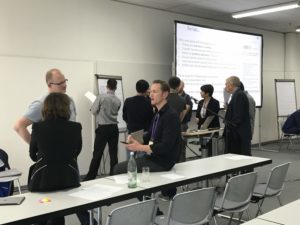AREA-supported ISMAR 2018 Workshop Explores Enterprise AR Requirements
The 17th IEEE International Symposium on Mixed and Augmented Reality took place this year at the MOC Conference Center in Munich, Germany from October 16th-20th. The first day of the conference was dedicated to workshops and the AREA was pleased to support this important event by hosting a half-day workshop on “Enterprise AR Requirements.”
Led by Michael Rygol and Christine Perey, the workshop attracted 33 attendees from a variety of commercial users of AR, as well as AR technology suppliers and academic/research institutions. With a truly international feel, we were pleased to welcome delegates from throughout Europe and North America, in addition to those from Japan, China and South Korea.

The workshop objectives included:
- Discussing five widely-validated AR use cases to collaboratively derive a set of structured and related requirements;
- Generating new content for the AREA’s recently launched AREA Statements of Need (ASON) management tool;
- Providing networking opportunities
Following the introductions, Nicole Le Minous and Muriel Deschanel, of B<>COM (a Technology Research Institute focused on digital technologies, based in France) presented insights from a recent survey of 77 participants regarding AR use cases and challenges. The presentation is now available to download.
Michael then discussed the need for structured and connected use cases and requirements in order to help move the AR ecosystem forward, with reference to the ASON taxonomy. The goals were to help vendors understand the AR requirements of their customers; and to provide companies seeking to use AR with a neutral view of needs from the industry itself.
The AREA’s ASON provides users with the ability to manage, connect, review and report numerous artifacts used to help articulate a neutral set of needs. Such artifacts include business process scenarios, use cases, requirements, personas, industries and settings, and more to help create an actionable repository of connected data.
The audience was then organized into five groups, each of which included AR users, suppliers and researchers. Each group discussed its overview use case definition and applied it to a setting of their choice, from which they created a set of requirements. These use cases were (with the group-chosen specific application in parentheses):
- Remote assistance with AR (onsite troubleshooting with a remote expert in an industrial setting)
- AR for complex assembly (factory assembly of medical devices)
- Inspection and quality assurance with AR (as-built vs. as-designed inspection for hotel construction)
- Virtual user interfaces with AR (utilities controls within restricted access buildings)
- AR for training (rapid training and instructions for business audio/video hardware installations)
To finish, a representative from each group presented a summary of their discussions.
The workshop was a very useful exercise and the content captured is now being entered into ASON for further use by the AREA community.